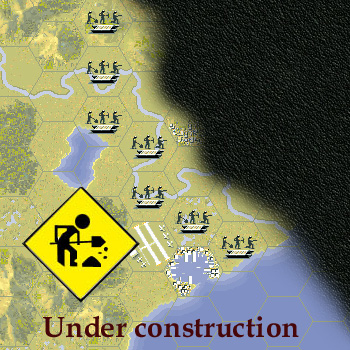Hypothetical battle. The Japanese invasion of Oahu Island immediately after the Pearl Harbor raid.
Japan surprise attack to USA the 7th December 1941. Yamamoto´s Plan considers from the very beginning the need of starting WWII with a great victory in sea.... and LAND... so Japan will try to take over Hawaii in the starting point of war.
American carriers were not in Pearl Harbor... but....may be that bearing in mind that this great army deployment cannot be completly undetected by the intelligence service of USA ... may be the US carriers....could not be so far...
Article on Czech Wikipedia
Article on English Wikipedia| Scenario in dates: |
| December 7, 1941: |
In Washington - The last part of the Japanese signal, stating specifically that relations are being broken is intercepted and decoded by the Americans. Delays in decoding of the message and difficulty in securing an appointment with Secretary Hull ensure that the Japanese delegation do not meet their country´s deadline for presentation of official note breaking of diplomatic ties until after the attack upon Pearl Harbor is launched. |
| December 7, 1941: |
Hawaii - At about 06:37 destroyer USS Ward (DD-139) sighted a periscope of submarine attempting to enter the Pearl Harbor by following cargo ships through the antisubmarine nets at the harbor entrance. Ward fired the first American shots of World War II, several rounds from its main guns, hitting the conning tower of the submarine, and also dropped several depth charges during the attack. Ward was Wickes-class destroyer serving in the United States Navy from World War I, she was built in record time: her keel was laid on 15 May 1918, launched only 17 days later on 1 June 1918, and commissioned 54 days after that on 24 July 1918. |
| December 7, 1941: |
In Hawaii - The Japanese attack launched from six carriers, Akagi, Kaga, Hiryu, Soryu, Zuikaku and Shokaku, carrying a total of 423 planes, begins at 0755 local time. Its target: the main base of the US Pacific Fleet at Pearl Harbor. There is complete tactical and strategic surprise. The Japanese task force, under the command of Admiral Nagumo, also contains 2 battleships, 2 heavy cruisers as well as destroyers and support vessels including tankers. Two attacking waves strike the naval base. The first lead by Commander Fuchida is comprised of 40 torpedo bombers carrying special shallow running torpedoes, 51 dive bombers, 50 high level bombers and 43 fighters. The second wave is comprised of similar numbers with more dive bombers replacing the torpedo planes. All eight of the US battleships in port are damaged. The USS Arizona (BB-39) sinks to the bottom with most hands onboard, the Oklahoma sinks but its later raised and scrapped. The USS California (BB-44), USS Nevada (BB-36) and USS West Virginia (BB-48) are later rebuilt and rejoin the fleet. Three cruisers and three destroyers are also sunk. The Americans lose 188 aircraft, the Japanese 29. Admiral Nagumo, despite the task forces´s capacity and against advice, does not send a third wave against the base. The three American aircraft carriers serving in the Pacific are not in port and escape unharmed as does much of the infrastructure of the port, including the oil storage tanks. However, the attack leaves the Allies with only the three US carriers and two British battleships as active capital ships in the theater. The cruisers destroyers and submarines available from the Dutch and Free French reduce the numerical inferiority against the Japanese navy, however, the Allied craft are widely dispersed and under multiple commands. |
|
Game play matters:
Scenario data:
Map size: 0 x 0 hexes
0 turns, 0 days per turn
Version: PacPG 2, Starting side: Axis, Campaign: Single scenario, Order in campaign: 0. |
| Axis states: | Japan |
| Allied states: | USA |
| Neutral states: | - |
|
| Axis: | defend |
| Allies: | defend |
|
| Experience of Axis purchased units: |  |
| Experience of Allied purchased units: |  |
|
| Climate region: | | Dry area |
| Weather character in region: | | Usually desert or area where was not rain during battle fights. |
|
Game time costingness of scenario: neurčeno %
(product of units and turns numbers divided by difference between the most long and the most short scenario)
|
Number of Axis units:
0 units, from them are 0 core units and 0 auxiliary units
0 air units, 0 naval units and 0 ground units
0 of units are loaded to air transport and 0 to naval transport
|
Transports Air/Naval:
Axis - Allies
0/0 - 0/0
|
Number of Allied units:
0 units
0 air units, 0 naval units and 0 ground units
0 of units are loaded to air transport and 0 to naval transport
|
Initial prestige + every turn donation:
Axis / Allies
40 + 0 / 40 + 0 |
Max number of Axis units:
0 units, from them are 0 core units and 0 auxiliary units
- on start of scenario is possible to purchase 0 unit
(0 core + 0 auxiliary)
|
Max number of Allied units:
0 units
- on start of scenario is possible to purchase 0 unit |
Transport units:
| Axis - air: | not available
|
| Allies - air: | not available
|
| Axis - naval: | not available
|
| Allies - naval: | not available
|
|
Victory conditions:
| Decisive strategic objects: |
|
0
|
| Major victory: |
|
0 |
| Minor victory: |
|
0
|
| Prestige donation for Major victory: |
|
500 |
| Prestige donation for Minor victory: |
|
200 |
|
Battle participated units:
Complete list of all units on map including coordinates, strenght, experience etc.
List of types participated units
Axis units:
|
Allied units:
| Map names list:
Battlefield map:
|
